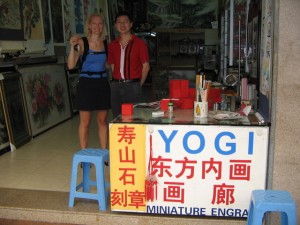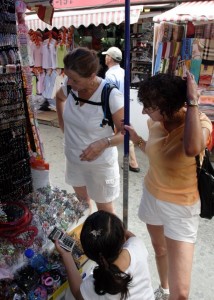Actually, no – it’s YOU!
My Dad’s work with Dell has offered my parents the opportunity to live abroad for two brief stints. Their first experience as expatriates landed them in Xiamen, China for 3 ½ years. Presently, they are in the final weeks of a summer in Limerick, Ireland.
If you ask my Mom about their travels, you are likely to hear some of her adventures filled with self-depricating humor. (Anyone who has ever met my Mom has undoubtedly heard her “My Trip to the Chinese Spa” story, which she recently submitted to Ellen.) Mom will often humbly speak with awe and wonder at how she—a kid from Upper Darby—has had this amazing opportunity to travel.
What really gives you insight into her daily experiences, however, is her photographs. It’s not the pictures of the sights that strike me. It’s the pictures she takes of people. Strangers. Ordinary people doing ordinary things in their own cultural context. My Mom might tell you that she’s inspired by the National Geographic images, or that she’s just capturing part of the experience of the country. But I’m certain it’s about something more.
About a year into my parents’stay in China, Mom had mastered many of the challenges expats face, but still struggled with just getting things done some days. She explained that she had a ton of errands to take care of…or rather it wasn’t actually that many…it was just that every errand literally took 12 times longer than it needed to because everyone wanted to talk with her. Picking up tickets from Apple, the travel agent took an hour. Shopping for jewelry meant another hour or two with Lenna, “the Pearl Lady.” And of course on her way to Lenna’s she had to stop by to see Yogi—whether she needed anything from his shop of handpainted knicknacks or not.




And it wasn’t just shopkeepers. The tiny young woman who Mom frequented for facials and massages—Sha-Sha—wanted to talk with her throughout the entire session. Same went for Mrs. Lee, her acupuncturist. Talking is a huge no-no in Mom’s book of relaxation, which I completely understand.
Mom couldn’t understand why all of the Chinese people she interacted with wanted to befriend her and talk. Maybe they want to work on their English, she surmised. Maybe they have just never seen a “big mamoo” like me.
Actually, no, Mom.
People are drawn to you because you see past their function and engage them as a human person. You greet the cashier at the airport parking booth with the same genuine care and concern that one would use for friends and family. People are drawn to you because of how you are with them.
The first time I began using the Catholic vocabulary word human dignity—the specialness, value, and worth each person has simply because we were created in the image and likeness of God—was when I started teaching a Peace and Justice class in the late 90’s. It may have been a new phrase to me, but it was by no means a foreign concept.
Respect for human dignity is one of the Seven Themes of Catholic Social Teaching. It is a foundational principle of who we are and how we practice our faith; respecting human dignity leads us to both moral behavior and acting with justice (which is precisely why I use it as a central concept when teaching).
Jewish theologian Martin Buber (d. 1965) contributes great insight to the ways in which we do (or do not) respect human dignity in his classic philosophical work I and Thou. Buber identifies and describes the two fundamental ways we relate to our fellow human beings:
I—It and I—You
I—It objectifies people, treating them as a means to an end. I—It uses people as things.
I—You exemplifies genuine care and concern for people as human beings. There is a real, personal presence in I-You encounters.
When we interact with other people, we either I—It them or we I—You them.
We immediately know it when we are on the receiving end of an I—It encounter. For me, the epitome of this is represented by the retail sales clerk who puts out her hand to receive payment and the customer absent-mindedly tosses money in her general direction.
The quality connection which occurs in the I—You encounter brings life and love to the participants. True human presence in an I—You exchange could be as simple as a non-verbal, eye-contact and head nod. Or it could be the conversation true friends share over a glass of wine. One thing is for sure, in that true human presence, we encounter the Divine: “in every You we address the eternal You” (Martin Buber, I and Thou. Translated by Walter Kaufman. New York: Charles Scribner’s Sons, 1970, 57 emphasis added).
I am so very fortunate to have had such an amazing example of respect for human dignity, and such a wonderful experience of I—You encounters with my Mom. Wishing her a Happy Birthday in Ireland. Cheers!
“Travel to china © Depositphotos.com/fiftycents”






